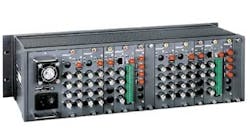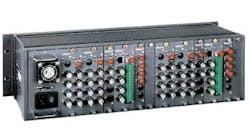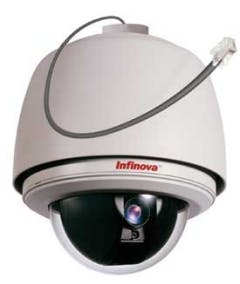The use of fiber optics in security and surveillance systems
Examining the ways fiber enhances the operation and business bottom line of surveillance solutions.
By Mark S. Wilson
With a transition from analog to digital video continuing, there remains a crucial requirement for reliable transmission of the video signal during today's period of coexistence. With many legacy installations it has been coaxial cable handling images from a camera to monitoring, recording or both. Coaxial has its limitations, including restricted transmission distance, signal degradation over long cable runs and interference.
Networking, digital and Internet Protocol (IP) have ushered in unshielded twisted-pair (UTP) cable and high-speed Ethernet, employing IP to carry the digitized video images. In some installations wireless transmission–radio-frequency, microwave, WiFi and mesh nets–play a role. Most enterprise security video designs are not totally wireless. Instead, the technology is applied to meet certain geographic or operational challenges.
When to choose fiber
And then there is fiber-optic cabling, with its interference immunity, better inherent security, robust distances and huge bandwidth capability. For the purposes of this article, we will look over the shoulders of a hypothetical chief security officer (CSO) named Terry Jones as well as Terry's second-in-command, Helena Smith. They work for a mid-sized enterprise and face the decisions and intricacies involved in selecting fiber optics and better understanding its advantages, installation and bottom-line business benefits.
This N3790 series transmitter is part of Infinova's fiber-optic transmission system for video-surveillance systems.
Differences exist among video signal transmission methods. Security end users, their designers, integrators and installers must consider and balance the methods with the needed functionality of cameras in light of the following characteristics.
- Maximum cable-run distances
- Power requirements
- Installation issues
- Installation time
- Quality of video
- Integration with other systems
- Cost
For years coaxial cabling has been the traditional transmission method of video-surveillance traffic. The presence of a coaxial BNC connector on most every security camera underlines this traditional method for signal transmission.
The most common coaxial cable is RG-59U. It provides what many believe is an acceptable quality video path from a camera to the head end out to 750 feet. That is because the maximum recommended distance between an analog security camera and a digital video recorder, head end or monitor is that same 750 feet.
When it comes to powering the camera, many installations employ so-called Siamese cable–a single RG-59U wedded to an attached 18/2 cable for both power and video. Still, some distances will increase voltage drop and it is necessary to select a power supply and cabling that match necessary voltage to distances. Today, and especially when it comes to new and upgraded installations containing scores of cameras, a minority have coaxial while the majority boast UTP (Category 5 or better) and fiber optics.
In some ways the security shift has been spurred by popularity of local area networks (LANs) in most enterprises. Information technology's (IT's) means of transmission gravitated to UTP wiring as well as fiber optics, often as an overall communications backbone. Cameras can be more easily installed using existing UTP cabling or fiber previously laid for enterprise network use. Corporate and government IP-based platforms have accelerated the transition. That naturally has swung security to such designs, especially when it involves video surveillance.
When it comes to UTP cabling, existing enterprise cables must be verified to be within security industry standards for video performance. UTP cabling, of course, is lighter and easier to install than RG-59U, which translates to lower end-user installation cost. And the cable itself is less expensive per-foot than comparable lengths of RG-59U.
This UTP-based camera from Infinova complies with ONVIF–Open Network Video Interface Forum–specifications.
Still, challenges remain when pushing analog video signals through UTP cable. It requires conversion of the camera's unbalanced BNC output into a balanced signal that can be carried on one pair of the UTP. When reaching a head end or recorder, the signal must be reconverted to handle a standard BNC-type connector. That often means the use of a balun.
Baluns and balance
Back to our CSO's office … When Terry asked what a balun is, Helena was quick to explain it is a device that connects a balanced line to an unbalanced line. It allows a signal of one impedance value to be transmitted over a cable that uses a different impedance. Impedance is simply a measure of opposition to alternating current. A video balun allows us, she says, to send video signals over a cable not meant for video. A common situation involving video baluns is use with Category 5 cable. Coaxial cable, which transmits video, has an impedance of 75 ohms while Category 5 has a 100-ohm impedance.
So baluns convert the original impedance to the impedance of the cable and then back. Baluns are used in pairs–one on each end of the cable. Transmitting video over UTP without the use of video baluns produces ghosting images because delays in the signal will occur. Baluns are available in passive and active varieties. Passive baluns convert the signal while active baluns impart an amplification method to increase transmission distance. In a four-pair UTP cable, typically one of the four pairs handles the video so three pairs can potentially provide power and pan/tilt/zoom control from a head end to a camera. Combinations of baluns are called hubs.
But it is fiber-optic technology, a method of sending and receiving information over great distances using light as the carrier, that boasts significant advantages, whether as a backbone or a total transmission solution. Some of fiber optics' more relevant advantages are listed here.
- Better-quality transmission
- No interference from lightning strikes, short circuits, crosstalk, EMI or RFI
- No interference from high voltages in fluorescent lights, card-access door strikes or outdoor lighting systems
- Better-quality transmission
- Light weight
- Stable within a wide temperature range
- Long service life
- Secure–not easily tapped into or interfered with
- Extremely high bandwidth
Allowance for growth as developments increase the amount of data transmitted
Fiber optics have been around for many years and should not be considered "bleeding-edge" technology. In fact, the principle that makes fiber-optic transmission possible was first demonstrated in the early 1840s. Practical applications developed early in the twentieth century before modern optical fibers, in which the glass fiber is coated with a transparent cladding to offer a more suitable refractive index. Just as consumer camcorders spurred CCD sensors into security video, consumer-driven cellular, television and Internet use more generally will accelerate development of fiber carrying images.
Consider transmission loss
Attenuation in fiber optics, also known as transmission loss, is the reduction in intensity of the light beam (or signal) with respect to distance travelled through a transmission medium. It is far less than the equivalent loss in copper cables, leading to long-haul fiber connections with repeater distances of 43 to 93 miles, or 70 to 150 kilometers. So there is no doubt that fiber optics can handle massive amounts of digital information across vast distances, and with immunity to interference.
Such functionality is built into fiber. A cross-section of fiber cables shows a Kevlar inner wrap and, because of this strong nonmetallic component, the cable cannot carry lightning pulses or transient voltages, such as those from an outdoor camera, into a facility. Within the fiber core, a blinking light-emitting diode (LED) is unaffected by electrical and radio-frequency anomalies.
Like other decisions that Terry and Helena face, there are challenges with fiber including material and installation cost, operation of the installation itself and ongoing maintenance. Smart security dealers and integrators, staying on top of their game and with their clients in mind, have invested in technician training and the proper tools and testers to handle fiber connections. And after installation, they know how best to troubleshoot.
There always remains the debate between creating and maintaining a standalone security systems transmission infrastructure or piggybacking on the corporate backbone. It is not necessarily one or the other; some designs can play it both ways. However, an obvious outcome of a separate, dedicated IT infrastructure for video and other physical-security applications is isolating that traffic from the general enterprise network. There are no "competition" or video-quality issues and there is sometimes a finer focus on security-system functionality and dependability. Yet there are technology advantages, both on the physical-security and IT sides such as higher-speed general networking, video compression/decompression modes and analytics at the edge, which tend to moot the standalone points. From organizational and budgetary perspectives, closer collaboration and sharing between security and IT are beneficial and are being encouraged today.
Uniquely, with fiber, physical security can have its own strands in the shared fiber bundle, thus achieving a standalone posture while also being part of the overall enterprise infrastructure.
Not afraid of the dark
"How much dark fiber do we already have?" is the next question Terry asks during their planning meeting. Dark fiber, or what some call unlit fiber, refers to unused optical fibers available in buildings and throughout local, regional and national networks. A good guess is that there are an estimated 80 million dark fibers installed in North America, thanks to the "dot-com" bubble of past years, new construction practices and technological advances in getting more traffic through the installed base. Often on the IT side, installers have almost always included extra fiber strands when installing structured cabling backbones between telecommunications rooms and separate buildings, for example.
That is because the cost of individual fiber strands is quite low, so extra strands have little impact on the budget. During installation it is not uncommon to break a fiber, so spares are handy to have with the aim that enough usable fibers will be available. And additional spare fibers often prepare an installation for the future.
So Jones's firm as well as many others may have existing fiber links not being used. Initial investment is cut and what installers call long cable pulls are significantly reduced. There still needs to be testing of dark fiber before considering it for security-video transmission. And, warns Helena, the type, quality and lengths of existing fiber links to be used, as well as the style of connectors installed on each end of the link, must be known.
Fiber-optic cabling comes in two basic types: multimode and singlemode. Multimode fiber has a core size of either 50 or 62.5 microns and commonly is found providing connections between telecommunications rooms within a building or campus. Preferred for most physical-security applications, multimode uses low-cost LEDs or inexpensive lasers for transmission. It is easier to terminate and test than singlemode. The drawback of multimode is its distance limitation, which is usually three miles. Singlemode fiber, with a core size of 7 to 10 microns, typically handles longer distances, sometimes more than 50 miles, in high-bandwidth applications.
Helena, with previous fiber applications under her belt, already realizes that fiber is superior to copper cabling in all performance measures. Available bandwidth of standard multimode fiber is many multiples that of Category 5 UTP. She reminds her boss not to forget that scores of cameras can transmit their signals over just one or two fiber strands.
There is a noticeable return on investment in cabling distances with fiber. Devices can move images up to two miles from end to end on multimode fiber, while high-bandwidth singlemode fiber can carry signals up to 60 miles before regeneration of the signal is needed.
The bandwidth capacity of a single stand of standard multimode fiber is more than 45 times that of Category 5 cable, while the maximum bandwidth capacity of singlemode fiber has yet to be reached. So even though IP-based video is gaining users, there remains a serious distance limitation with UTP cabling infrastructure, which hinders placement of cameras. For example, if a camera is located 1,000 feet from the head end, without any active signal conditioning at some cost, about 37 percent of the information will be lost in transmission, not counting the need and cost for signal amplification, ground-fault correction and surge protection.
Fiber as a prime security tool opens the application doorway extraordinarily wide. There are almost unlimited capabilities of security-video transmission and pan/tilt/zoom controls, for instance.
Multimode and singlemode
Fiber within most buildings is multimode, for the most part. Some infrastructures, such as those for Terry and Helena, have a combination of multimode and singlemode. No matter the mode, there needs to be a way to convert the video signal over to an optical format and back again. So several devices are part of a fiber-optic transmission system, including receivers and transmitters (which can be combined into transceivers), video-to-fiber converters, connectors and adapters.
Fiber connectors, for instance, are available in several common styles such as ST, SC and LC. These styles come into play when realizing that the devices for interfacing physical-security equipment to fiber-optic links usually can be ordered with either the ST or SC connector. Various adapters convert connections, such as connecting an ST video fiber encoder to an SC connector on a network fiber patch panel.
When facing the coexistence of analog and digital IP, consider the cost of analog-to-fiber. However, the increasing speed of the migration to IP will continue to change that equation. In addition to providing a means for transparently connecting one type of media to another, media conversion can provide a cost-effective method for integrating a hybrid video security system into one, seamless and manageable whole. Cost savings can be realized thanks to an existing, analog-based security-video infrastructure, while coexisting with the latest technology of IP-based cameras for video capture, storage or analysis as well as for expanded application of megapixel and HD cameras at added locations.
Coaxial, UTP or fiber optics? Take your pick. But in coexisting analog/IP security-video situations and truly when it comes, sooner or later, to fully digital and IP environments, fiber optics can light the way.
Why you will see ONVIF everywhere in 2011
There is simply no question about it. End users want the increased benefits of digital/IP video. But they (whether end user or integrator) run into big roadblocks on their journey from analog to digital. With digital surveillance, it is no longer simple to mix and match analog cameras and DVR brands. With digital, the basic components of a network video system are often non-standard, including the IP camera, network video recorder (NVR) and video management software (VMS).
Integrators have been tearing their hair out because, seemingly, every digital camera vendor has created a separate camera interface. Oh yes, there are standards in the networked surveillance industry–compression (H.264, MPEG-4) and streaming (RSTP) for example–but control and command interfaces are not standard yet. Thus, software and NVR manufacturers must create camera-specific interfaces to their solutions.
The good old days of analog plug-and-play are of the past. Now there is the challenge of interoperability among hardware-to-hardware and hardware-to-software implementations. As a result many integrators are hesitant to promote digital surveillance solutions even though their customers want them.
To help, leading VMS vendors including Milestone and Video Insight have integrated hundreds of cameras and encoders into their platforms. Even so, integration between devices is lacking. For instance, the software supports some features on one camera but not on another.
Again it is the integrator who's on the line, having to determine if and how much interoperability there is between the selected software, cameras and recorders. This is the crux of why the Open Network Video Interface Forum (ONVIF) has become so important.
If a product carries ONVIF certification, integration is standardized. ONVIF-certified products work with other ONVIF-certified products. If the integrator and end user agree on using only ONVIF-certified products, we are on our way back to the plug-and-play world of analog.
Why ONVIF? ONVIF is real. It provides a standard to address interoperability problems in network video, including such important needs as defining interfaces for device configuration, event handling, pan/tilt/zoom control and similar issues. Most importantly, it has been embraced by the great majority of digital/IP manufacturers, software and hardware. This will be verified by a quick stroll through most of the leading events globally. Booth after booth will tout ONVIF certification. -MSW
Mark S. Wilson is vice president of marketing with Infinova (www.infinova.com), which manufactures product lines for analog and IP, coaxial- twisted-pair- and fiber-optic-based transmission of video surveillance. This article is excerpted from his white paper entitled "Connecting it all together: Fiber optics in security and surveillance solutions."
Past CIM Issues


